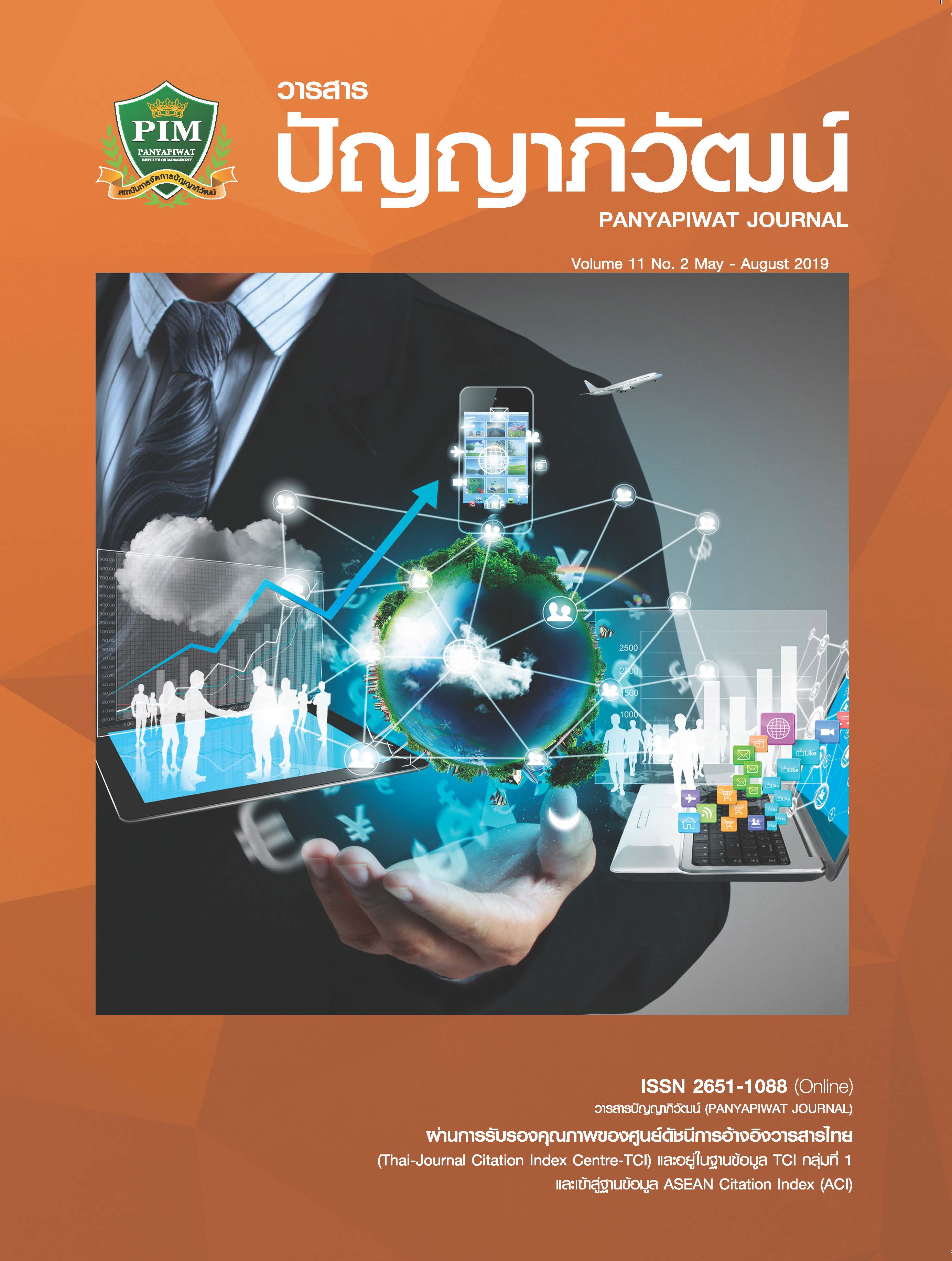ความสัมพันธ์เชิงสาเหตุของประสิทธิผลในการใช้เทคโนโลยีสารสนเทศและการสื่อสาร ของอาจารย์มหาวิทยาลัยราชภัฏในเขตภาคเหนือ
Main Article Content
บทคัดย่อ
การวิจัยครั้งนี้มีวัตถุประสงค์เพื่อพัฒนาและตรวจสอบรูปแบบความสัมพันธ์เชิงสาเหตุของประสิทธิผลในการใช้เทคโนโลยีสารสนเทศและการสื่อสารของอาจารย์มหาวิทยาลัยราชภัฏในเขตภาคเหนือ กลุ่มตัวอย่างที่ใช้ในการวิจัยคือ อาจารย์มหาวิทยาลัยราชภัฏในเขตภาคเหนือ จำนวน 324 คน เครื่องมือที่ใช้ในการวิจัยเป็นแบบสอบถามที่มีค่าความเชื่อมั่นตามวิธีหาค่าสัมประสิทธิ์แอลฟาของครอนบาคเท่ากับ 0.95 วิเคราะห์ข้อมูลโดยใช้สถิติเชิงพรรณนาและวิเคราะห์แบบจำลองความสัมพันธ์เชิงสาเหตุโดยใช้วิธีการวิเคราะห์สมการโครงสร้าง
ผลการวิจัยสรุปได้ว่า รูปแบบความสัมพันธ์เชิงสาเหตุที่พัฒนาขึ้นมีความสอดคล้องกับข้อมูลเชิงประจักษ์ด้วยค่าสถิติ χ2 = 10.801, df = 9, p = .290, χ2/df = 1.200, GFI = .992, และ RMSEA = .025 การจัดการทรัพยากร การติดต่อสื่อสารและกิจกรรมส่งเสริม และภาวะผู้นำของผู้บริหาร มีอิทธิพลทางตรงต่อประสิทธิผลในการใช้เทคโนโลยีสารสนเทศและการสื่อสาร โดยมีค่าสัมประสิทธิ์อิทธิพลเท่ากับ 0.63, 0.20 และ 0.12 ตามลำดับ การวัดและประเมินผล วัฒนธรรมองค์กร และภาวะผู้นำของผู้บริหาร มีอิทธิพลทางอ้อมต่อประสิทธิผลในการใช้เทคโนโลยี
สารสนเทศและการสื่อสาร โดยมีค่าสัมประสิทธิ์อิทธิพลเท่ากับ 0.53, 0.10 และ 0.34 ตามลำดับ
Article Details
“ข้าพเจ้าและผู้เขียนร่วม (ถ้ามี) ขอรับรองว่า บทความที่เสนอมานี้ยังไม่เคยได้รับการตีพิมพ์และไม่ได้อยู่ระหว่างกระบวนการพิจารณาลงตีพิมพ์ในวารสารหรือแหล่งเผยแพร่อื่นใด ข้าพเจ้าและผู้เขียนร่วมยอมรับหลักเกณฑ์การพิจารณาต้นฉบับ ทั้งยินยอมให้กองบรรณาธิการมีสิทธิ์พิจารณาและตรวจแก้ต้นฉบับได้ตามที่เห็นสมควร พร้อมนี้ขอมอบลิขสิทธิ์บทความที่ได้รับการตีพิมพ์ให้แก่สถาบันการจัดการปัญญาภิวัฒน์หากมีการฟ้องร้องเรื่องการละเมิดลิขสิทธิ์เกี่ยวกับภาพ กราฟ ข้อความส่วนใดส่วนหนึ่งและ/หรือข้อคิดเห็นที่ปรากฏในบทความข้าพเจ้าและผู้เขียนร่วมยินยอมรับผิดชอบแต่เพียงฝ่ายเดียว”
เอกสารอ้างอิง
Barnard, C. (1966). The function of executive. Cambridge, USA: Harvard University press.
Brown, M. & Cudek, R. (1992). Alternative ways of assessing model ft. In K. A. Bollen, J. S. Ling (Eds.). Testing structural equation models. Beverly Hill, CA: Sage.
Byrne, B. M. (2001). Structural equation modeling with AMOS basic concept, application, and programming. New Jersey: Lawrence Erlbaum Associate.
Carty, B. & Phillip, B. (2001). The nursing curriculum in the information in the information age. In Saba (Ed.).
Essentials of computers for nurses: informatics for the new millennium. (3rd ed.). New York: McGraw-Hill.
Chandarasorn, V. (2013). The theory of public policy implementation (6th ed.). Bangkok: Prikwan Graphic. [in Thai]
Chuenwisit, C. (2002). Relationships between personal factors, ability in using computer, organization environment, and ability in using information technology for management of head nurses, governmental hospitals under the jurisdiction of the ministry of public health, Bangkok metropolis. Master of Nursing Science, Chulalongkorn University. [in Thai]
Collis, B. & Wende, V. M. (2002). Models of change: ICT and the Internationalization of higher education. Journal of Studies in International Education, 6(2), 87-200.
Cronbach, L. J. (1951). Coeffcient alpha and the internal structure of tests. Psychometrika, 16(3), 297-334.
Drucker, P. F. (1995). Innovation and entrepreneurship, butterworth heinemann, clinical information system.
Computer in Nursing, 15(2), 71-76.
Kline, R. B. (2005). Principle and Practice of Structural Equation Modeling. New York: The Guilford Press.
Krothe, J., Pappas, V. & Minnick, L. (1996). Nursing students use of collaborative-computer technology to create family and community assessment instrument. Computer in Nursing, 14(2), 101-107.
Mapangmo, S. (2012). Relationship between full leadership of school administrators with the information technology and communication management of the schoolunder the offce of the secondary education service area 21. Nakhon Phanom University, 2(1), 101-108. [in Thai]
Marasovic, C., Kenny, C., Elliot, D. & Sind-husake, D. (1997). Attitude of Australian nurse toward implementation of a clinical information system. Computer in Nursing, 15(2), 71-76.
Middieton, P. (2002). Barriers to the effcient and effective use of Information Technology. The International Journal of Public Sector Management, 13(1), 85-99.
Ministry of Education. (2014). Master Plan for Information and Communication Technology for Education. Ministry of Education, 2014-2016. Retrieved October 10, 2015, from https://drive.google.com/fle/d/0B8hb_xCL9LsPazcyNVg4WHZQUTA/view [in Thai]
Ministry of Information and Communication Technology. (2014). Master Plan for Information and Communication Technology No. 3, 2011-2020. Retrieved October 10, 2015, from https://www.oic.go.th/FILEWEB/CABINFOCENTER3/DRAWER088/GENERAL/DATA0000/00000498.PDF [in Thai]
Narapong, V. (1999). Personal factors, environmental support in using computer, ability of computer utilization of nursing instructors in nursing colleges under the jurisdiction of the ministry of public health. Master of Nursing Science, Chulalongkorn University. [in Thai]
National Science and Technology Development Agency. (1997). Annual Report 1997. Bangkok: National Science and Technology Development Agency. [in Thai]
Phunumkang, C. (2005). Information and Communication Technology Needs for Agricultural Extension Workers in the Northeastern Region. Master of Science, Khon Kaen University. [in Thai]
Schein, E. M. (1990). Organizational Culture. American Psychologist, 45(2), 109-119.
Schumacker, R. E. & Lomax, R. G. (2004). A Beginner’s Guide to Structural Equation Modeling (2nd ed.). New Jersey: Lawrence Erlbaum Associates.
Seammai, N. (2011). A Study of Adoption of e-Government Information Technology (G2E) of Service Level Offcials Case Study: Offce of the Permanent Secretary, Ministry of Interior and Offce of the Permanent Secretary, Ministry of Information and Communication Technology. Master of Science, Thammasat University. [in Thai]
Seenuankaew, S. (2010). Success factors to ICT use for social development to quality society in developing countries. Academic Resource, 21(2), 126-138. [in Thai]
Senge, P. M. (1990). The ffth discipline: the art and practice of the learning organization. New York: Doubleday.
Stevens, J. (1986). Applied multivariate statistics for the social sciences. Hillsdale, NJ: Lawrence Erlbaum Associates.
Teawchanteuk, S. (2000). The knowledge and skills of nurses in utilizing information technology for work in community hospitals in the central region. Master of Nursing Science, Mahidol University. [in Thai]
Wangpipatwong, T. (2007). Application of ICT for Education. Bangkok: Bangkok University. [in Thai]
Whittaker, R. H. (1975). Communities and ecosystems (2nd ed.). New York: Macmillan.
Wongwanich, V. (2012). Organizational Factors in Knowledge Management Affecting Knowledge Management of Information and Communication Technology in Schools under the Offce of Secondary Education Region 10, Phetchaburi Province. Silpakorn Educational Research Journal, 4(1), 237-246. [in Thai]


